Power, MT Map & Demographics
Power Map
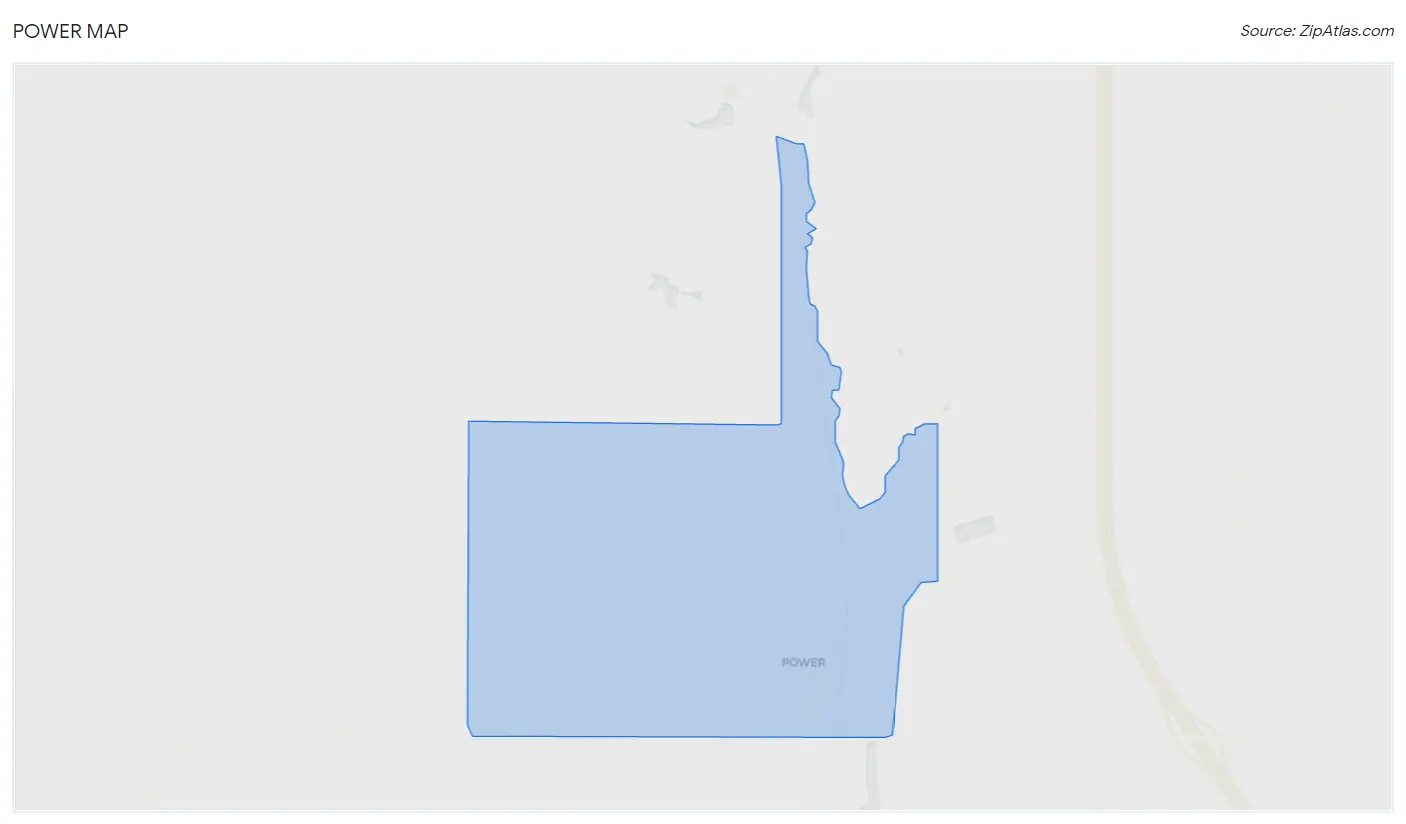
Power Overview
$28,771
PER CAPITA INCOME
$80,250
AVG FAMILY INCOME
$70,375
AVG HOUSEHOLD INCOME
18.6%
WAGE / INCOME GAP [ % ]
81.4¢/ $1
WAGE / INCOME GAP [ $ ]
0.28
INEQUALITY / GINI INDEX
197
TOTAL POPULATION
96
MALE POPULATION
101
FEMALE POPULATION
95.05
MALES / 100 FEMALES
105.21
FEMALES / 100 MALES
41.1
MEDIAN AGE
3.3
AVG FAMILY SIZE
2.2
AVG HOUSEHOLD SIZE
96
LABOR FORCE [ PEOPLE ]
64.4%
PERCENT IN LABOR FORCE
Power Zip Codes
Power Area Codes
Income in Power
Income Overview in Power
Per Capita Income in Power is $28,771, while median incomes of families and households are $80,250 and $70,375 respectively.
| Characteristic | Number | Measure |
| Per Capita Income | 197 | $28,771 |
| Median Family Income | 45 | $80,250 |
| Mean Family Income | 45 | $79,027 |
| Median Household Income | 91 | $70,375 |
| Mean Household Income | 91 | $64,420 |
| Income Deficit | 45 | $0 |
| Wage / Income Gap (%) | 197 | 18.64% |
| Wage / Income Gap ($) | 197 | 81.36¢ per $1 |
| Gini / Inequality Index | 197 | 0.28 |
Earnings by Sex in Power
Average Earnings in Power are $33,750, $36,875 for men and $30,000 for women, a difference of 18.6%.

| Sex | Number | Average Earnings |
| Male | 68 (63.0%) | $36,875 |
| Female | 40 (37.0%) | $30,000 |
| Total | 108 (100.0%) | $33,750 |
Earnings by Sex by Income Bracket in Power
The most common earnings brackets in Power are $12,500 to $14,999 for men (13 | 19.1%) and $65,000 to $74,999 for women (9 | 22.5%).
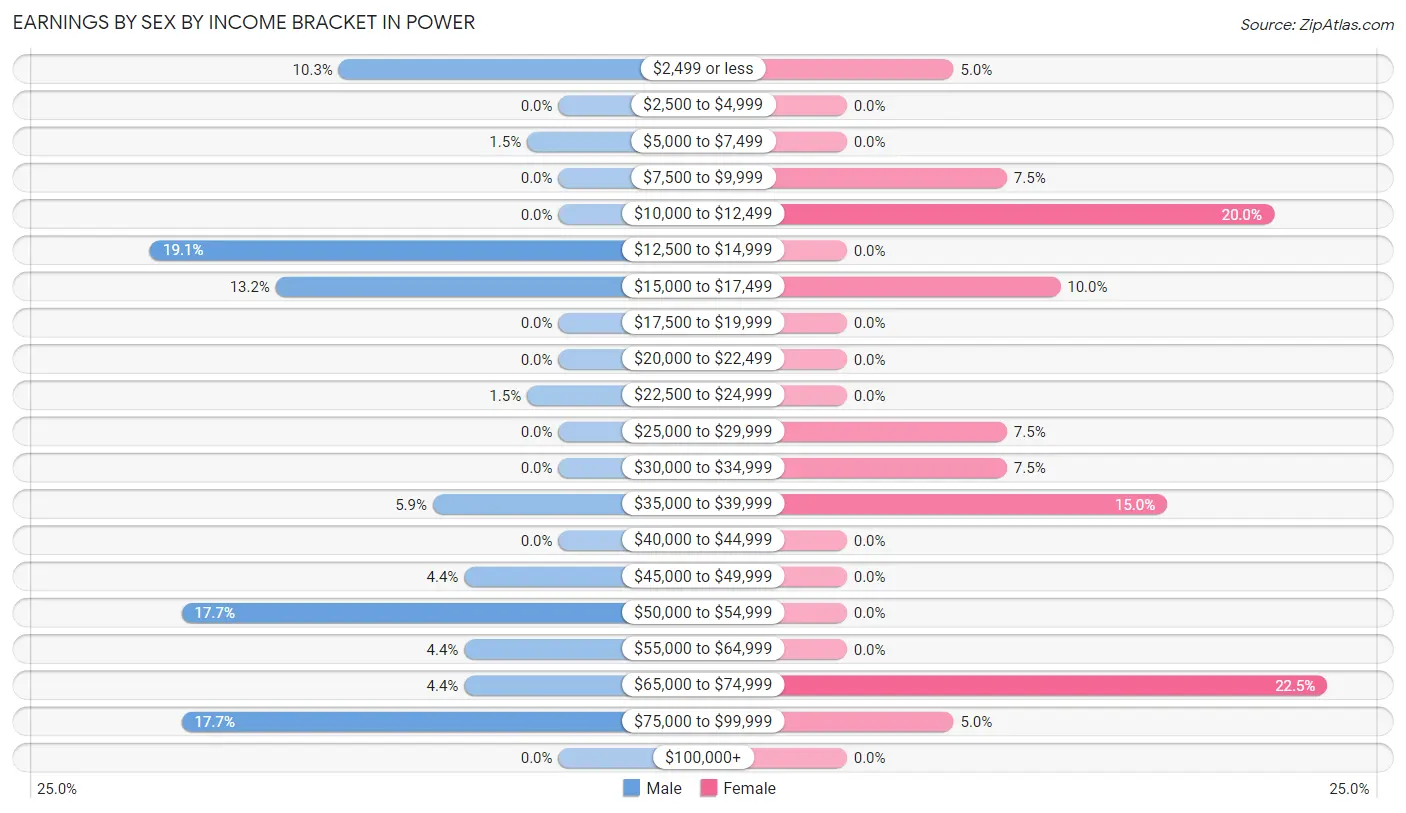
| Income | Male | Female |
| $2,499 or less | 7 (10.3%) | 2 (5.0%) |
| $2,500 to $4,999 | 0 (0.0%) | 0 (0.0%) |
| $5,000 to $7,499 | 1 (1.5%) | 0 (0.0%) |
| $7,500 to $9,999 | 0 (0.0%) | 3 (7.5%) |
| $10,000 to $12,499 | 0 (0.0%) | 8 (20.0%) |
| $12,500 to $14,999 | 13 (19.1%) | 0 (0.0%) |
| $15,000 to $17,499 | 9 (13.2%) | 4 (10.0%) |
| $17,500 to $19,999 | 0 (0.0%) | 0 (0.0%) |
| $20,000 to $22,499 | 0 (0.0%) | 0 (0.0%) |
| $22,500 to $24,999 | 1 (1.5%) | 0 (0.0%) |
| $25,000 to $29,999 | 0 (0.0%) | 3 (7.5%) |
| $30,000 to $34,999 | 0 (0.0%) | 3 (7.5%) |
| $35,000 to $39,999 | 4 (5.9%) | 6 (15.0%) |
| $40,000 to $44,999 | 0 (0.0%) | 0 (0.0%) |
| $45,000 to $49,999 | 3 (4.4%) | 0 (0.0%) |
| $50,000 to $54,999 | 12 (17.6%) | 0 (0.0%) |
| $55,000 to $64,999 | 3 (4.4%) | 0 (0.0%) |
| $65,000 to $74,999 | 3 (4.4%) | 9 (22.5%) |
| $75,000 to $99,999 | 12 (17.6%) | 2 (5.0%) |
| $100,000+ | 0 (0.0%) | 0 (0.0%) |
| Total | 68 (100.0%) | 40 (100.0%) |
Earnings by Sex by Educational Attainment in Power

| Educational Attainment | Male Income | Female Income |
| Less than High School | - | - |
| High School Diploma | $53,750 | $0 |
| College or Associate's Degree | - | - |
| Bachelor's Degree | $51,964 | $30,417 |
| Graduate Degree | - | - |
| Total | $47,083 | $0 |
Family Income in Power
Family Income Brackets in Power
According to the Power family income data, there are 24 families falling into the $75,000 to $99,999 income range, which is the most common income bracket and makes up 53.3% of all families.

| Income Bracket | # Families | % Families |
| Less than $10,000 | 1 | 2.2% |
| $10,000 to $14,999 | 0 | 0.0% |
| $15,000 to $24,999 | 0 | 0.0% |
| $25,000 to $34,999 | 3 | 6.7% |
| $35,000 to $49,999 | 0 | 0.0% |
| $50,000 to $74,999 | 8 | 17.8% |
| $75,000 to $99,999 | 24 | 53.3% |
| $100,000 to $149,999 | 9 | 20.0% |
| $150,000 to $199,999 | 0 | 0.0% |
| $200,000+ | 0 | 0.0% |
Family Income by Famaliy Size in Power
2-person families (28 | 62.2%) account for the highest median family income in Power with $81,000 per family, while 2-person families (28 | 62.2%) have the highest median income of $40,500 per family member.

| Income Bracket | # Families | Median Income |
| 2-Person Families | 28 (62.2%) | $81,000 |
| 3-Person Families | 1 (2.2%) | $0 |
| 4-Person Families | 4 (8.9%) | $0 |
| 5-Person Families | 8 (17.8%) | $0 |
| 6-Person Families | 0 (0.0%) | $0 |
| 7+ Person Families | 4 (8.9%) | $0 |
| Total | 45 (100.0%) | $80,250 |
Family Income by Number of Earners in Power

| Number of Earners | # Families | Median Income |
| No Earners | 5 (11.1%) | $0 |
| 1 Earner | 13 (28.9%) | $79,375 |
| 2 Earners | 19 (42.2%) | $90,417 |
| 3+ Earners | 8 (17.8%) | $0 |
| Total | 45 (100.0%) | $80,250 |
Household Income in Power
Household Income Brackets in Power
With 24 households falling in the category, the $35,000 to $49,999 income range is the most frequent in Power, accounting for 26.4% of all households.

| Income Bracket | # Households | % Households |
| Less than $10,000 | 3 | 3.3% |
| $10,000 to $14,999 | 7 | 7.7% |
| $15,000 to $24,999 | 0 | 0.0% |
| $25,000 to $34,999 | 3 | 3.3% |
| $35,000 to $49,999 | 24 | 26.4% |
| $50,000 to $74,999 | 17 | 18.7% |
| $75,000 to $99,999 | 24 | 26.4% |
| $100,000 to $149,999 | 11 | 12.1% |
| $150,000 to $199,999 | 2 | 2.2% |
| $200,000+ | 0 | 0.0% |
Household Income by Householder Age in Power
The median household income in Power is $70,375, with the highest median household income of $86,250 found in the 45 to 64 years age bracket for the primary householder. A total of 22 households (24.2%) fall into this category. Meanwhile, the 15 to 24 years age bracket for the primary householder has the lowest median household income of $0, with 8 households (8.8%) in this group.

| Income Bracket | # Households | Median Income |
| 15 to 24 Years | 8 (8.8%) | $0 |
| 25 to 44 Years | 23 (25.3%) | $76,406 |
| 45 to 64 Years | 22 (24.2%) | $86,250 |
| 65+ Years | 38 (41.8%) | $44,167 |
| Total | 91 (100.0%) | $70,375 |
Poverty in Power
Income Below Poverty by Sex and Age in Power
With 13.5% poverty level for males and 3.0% for females among the residents of Power, under 5 year old males and 75 year old and over females are the most vulnerable to poverty, with 2 males (50.0%) and 2 females (100.0%) in their respective age groups living below the poverty level.
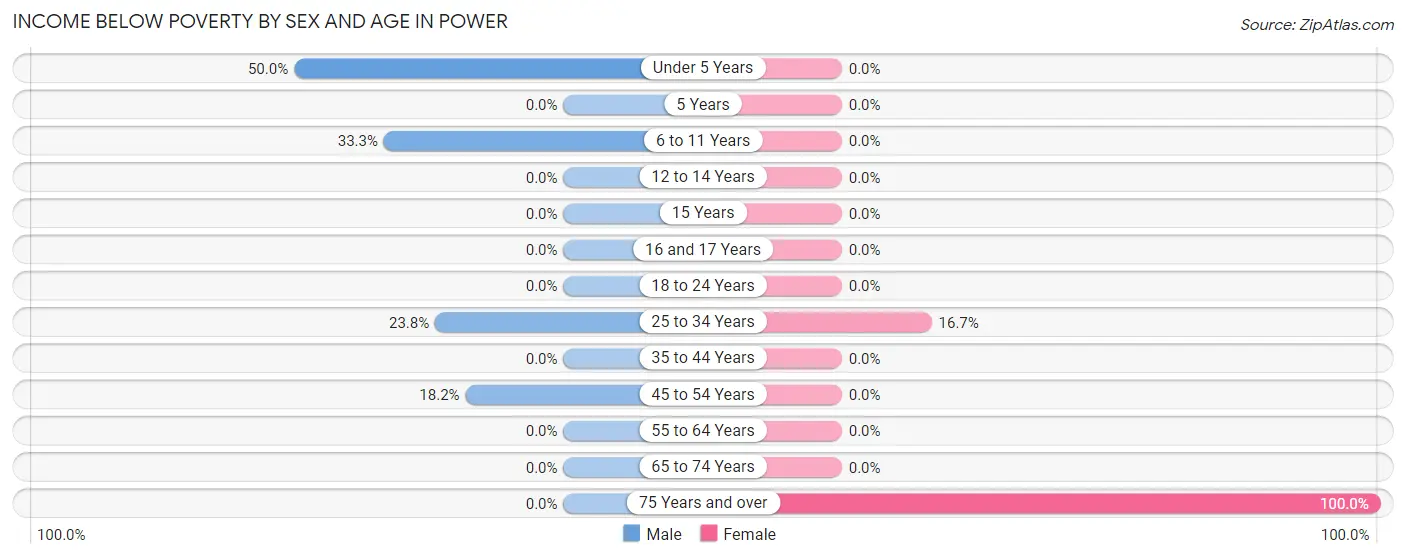
| Age Bracket | Male | Female |
| Under 5 Years | 2 (50.0%) | 0 (0.0%) |
| 5 Years | 0 (0.0%) | 0 (0.0%) |
| 6 to 11 Years | 4 (33.3%) | 0 (0.0%) |
| 12 to 14 Years | 0 (0.0%) | 0 (0.0%) |
| 15 Years | 0 (0.0%) | 0 (0.0%) |
| 16 and 17 Years | 0 (0.0%) | 0 (0.0%) |
| 18 to 24 Years | 0 (0.0%) | 0 (0.0%) |
| 25 to 34 Years | 5 (23.8%) | 1 (16.7%) |
| 35 to 44 Years | 0 (0.0%) | 0 (0.0%) |
| 45 to 54 Years | 2 (18.2%) | 0 (0.0%) |
| 55 to 64 Years | 0 (0.0%) | 0 (0.0%) |
| 65 to 74 Years | 0 (0.0%) | 0 (0.0%) |
| 75 Years and over | 0 (0.0%) | 2 (100.0%) |
| Total | 13 (13.5%) | 3 (3.0%) |
Income Above Poverty by Sex and Age in Power
According to the poverty statistics in Power, males aged 12 to 14 years and females aged under 5 years are the age groups that are most secure financially, with 100.0% of males and 100.0% of females in these age groups living above the poverty line.
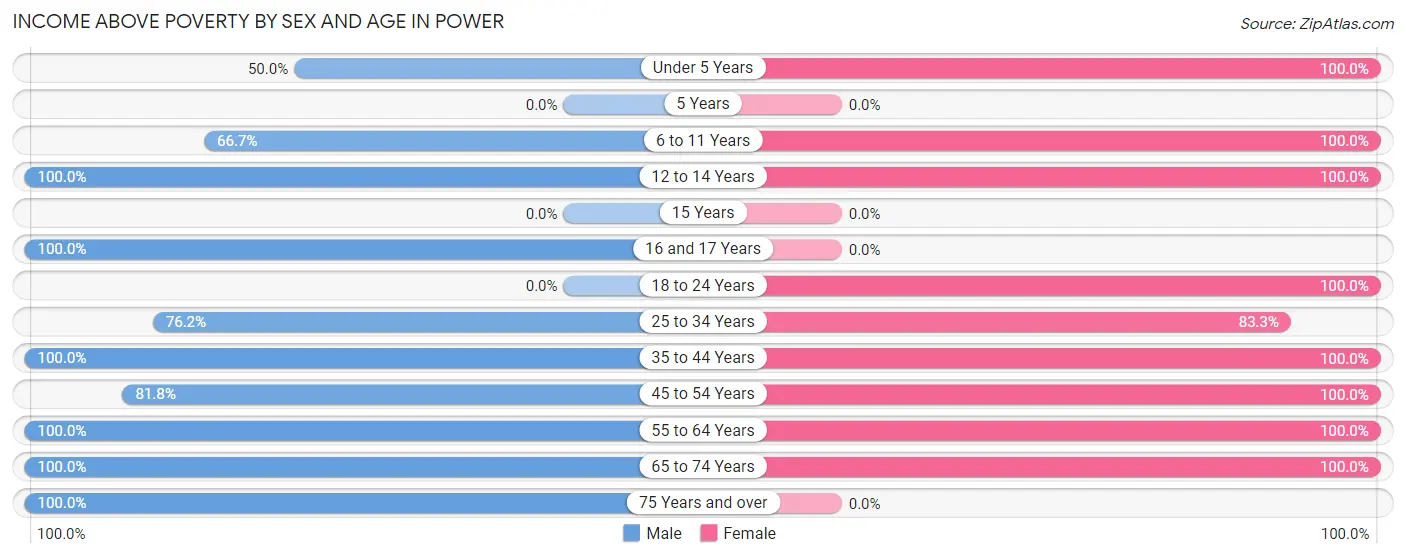
| Age Bracket | Male | Female |
| Under 5 Years | 2 (50.0%) | 12 (100.0%) |
| 5 Years | 0 (0.0%) | 0 (0.0%) |
| 6 to 11 Years | 8 (66.7%) | 10 (100.0%) |
| 12 to 14 Years | 2 (100.0%) | 8 (100.0%) |
| 15 Years | 0 (0.0%) | 0 (0.0%) |
| 16 and 17 Years | 7 (100.0%) | 0 (0.0%) |
| 18 to 24 Years | 0 (0.0%) | 8 (100.0%) |
| 25 to 34 Years | 16 (76.2%) | 5 (83.3%) |
| 35 to 44 Years | 4 (100.0%) | 19 (100.0%) |
| 45 to 54 Years | 9 (81.8%) | 3 (100.0%) |
| 55 to 64 Years | 15 (100.0%) | 12 (100.0%) |
| 65 to 74 Years | 5 (100.0%) | 21 (100.0%) |
| 75 Years and over | 15 (100.0%) | 0 (0.0%) |
| Total | 83 (86.5%) | 98 (97.0%) |
Income Below Poverty Among Married-Couple Families in Power

| Children | Above Poverty | Below Poverty |
| No Children | 22 (100.0%) | 0 (0.0%) |
| 1 or 2 Children | 12 (100.0%) | 0 (0.0%) |
| 3 or 4 Children | 0 (0.0%) | 0 (0.0%) |
| 5 or more Children | 4 (100.0%) | 0 (0.0%) |
| Total | 38 (100.0%) | 0 (0.0%) |
Income Below Poverty Among Single-Parent Households in Power

| Children | Single Father | Single Mother |
| No Children | 0 (0.0%) | 0 (0.0%) |
| 1 or 2 Children | 0 (0.0%) | 0 (0.0%) |
| 3 or 4 Children | 0 (0.0%) | 1 (100.0%) |
| 5 or more Children | 0 (0.0%) | 0 (0.0%) |
| Total | 0 (0.0%) | 1 (20.0%) |
Income Below Poverty Among Married-Couple vs Single-Parent Households in Power

| Children | Married-Couple Families | Single-Parent Households |
| No Children | 0 (0.0%) | 0 (0.0%) |
| 1 or 2 Children | 0 (0.0%) | 0 (0.0%) |
| 3 or 4 Children | 0 (0.0%) | 1 (100.0%) |
| 5 or more Children | 0 (0.0%) | 0 (0.0%) |
| Total | 0 (0.0%) | 1 (14.3%) |
Race in Power
The most populous races in Power are White / Caucasian (169 | 85.8%), Native / Alaskan (26 | 13.2%), and Two or more Races (2 | 1.0%).

| Race | # Population | % Population |
| Asian | 0 | 0.0% |
| Black / African American | 0 | 0.0% |
| Hawaiian / Pacific | 0 | 0.0% |
| Hispanic or Latino | 0 | 0.0% |
| Native / Alaskan | 26 | 13.2% |
| White / Caucasian | 169 | 85.8% |
| Two or more Races | 2 | 1.0% |
| Some other Race | 0 | 0.0% |
| Total | 197 | 100.0% |
Ancestry in Power
The most populous ancestries reported in Power are German (63 | 32.0%), Irish (32 | 16.2%), Swedish (31 | 15.7%), Blackfeet (26 | 13.2%), and Norwegian (22 | 11.2%), together accounting for 88.3% of all Power residents.
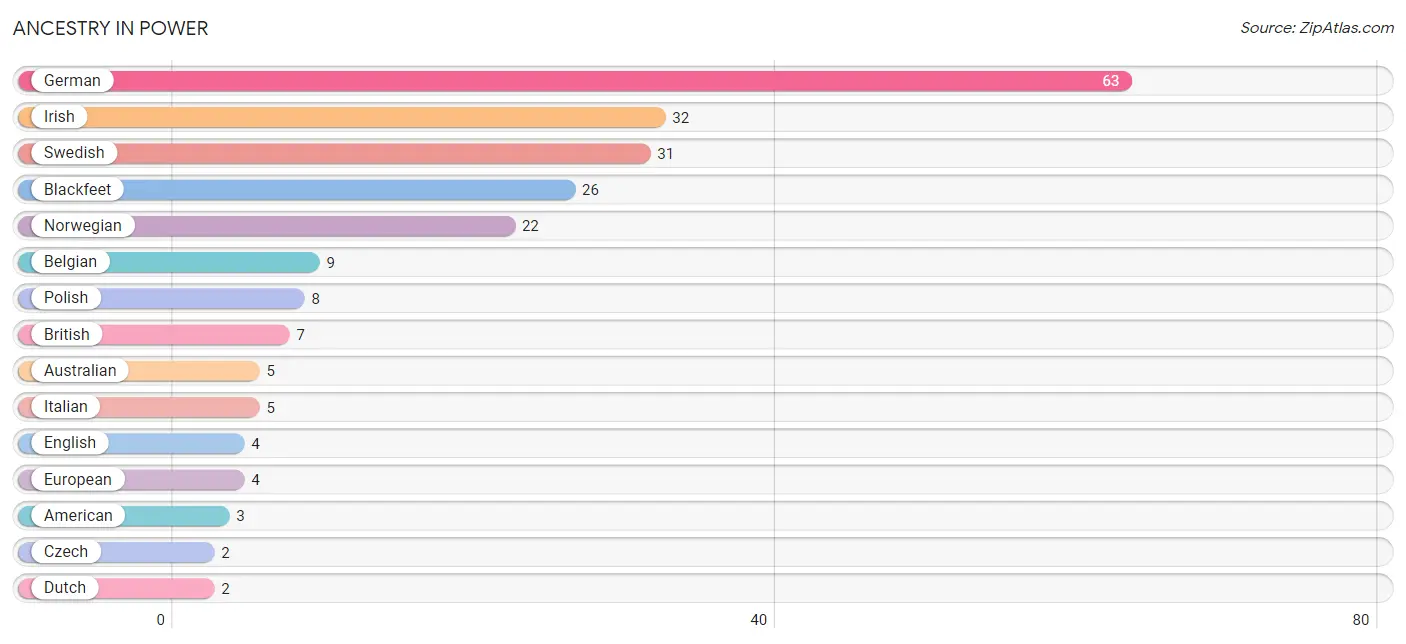
| Ancestry | # Population | % Population |
| American | 3 | 1.5% |
| Australian | 5 | 2.5% |
| Belgian | 9 | 4.6% |
| Blackfeet | 26 | 13.2% |
| British | 7 | 3.5% |
| Czech | 2 | 1.0% |
| Danish | 1 | 0.5% |
| Dutch | 2 | 1.0% |
| English | 4 | 2.0% |
| European | 4 | 2.0% |
| German | 63 | 32.0% |
| Hungarian | 2 | 1.0% |
| Irish | 32 | 16.2% |
| Italian | 5 | 2.5% |
| Norwegian | 22 | 11.2% |
| Polish | 8 | 4.1% |
| Swedish | 31 | 15.7% | View All 17 Rows |
Immigrants in Power

| Immigration Origin | # Population | % Population | View All 0 Rows |
Sex and Age in Power
Sex and Age in Power
The most populous age groups in Power are 25 to 29 Years (16 | 16.7%) for men and 70 to 74 Years (14 | 13.9%) for women.
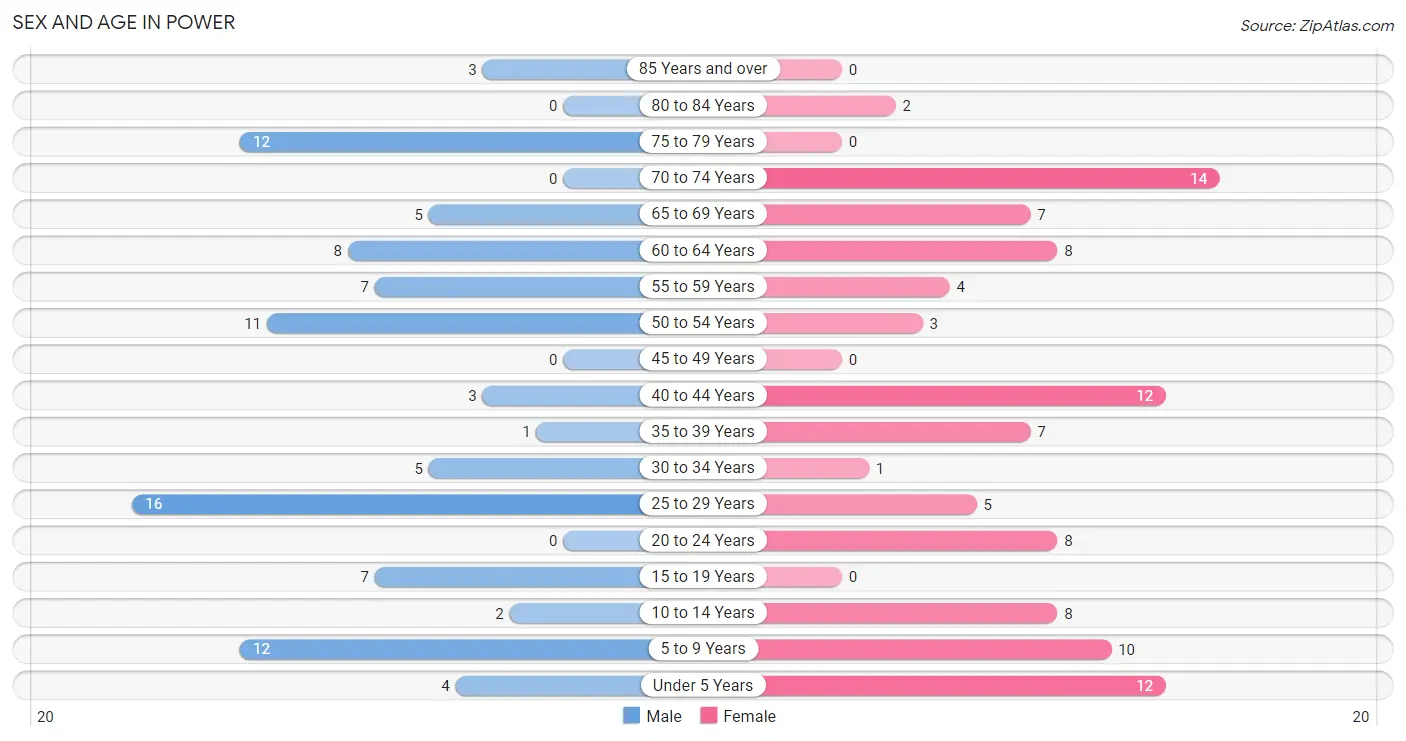
| Age Bracket | Male | Female |
| Under 5 Years | 4 (4.2%) | 12 (11.9%) |
| 5 to 9 Years | 12 (12.5%) | 10 (9.9%) |
| 10 to 14 Years | 2 (2.1%) | 8 (7.9%) |
| 15 to 19 Years | 7 (7.3%) | 0 (0.0%) |
| 20 to 24 Years | 0 (0.0%) | 8 (7.9%) |
| 25 to 29 Years | 16 (16.7%) | 5 (5.0%) |
| 30 to 34 Years | 5 (5.2%) | 1 (1.0%) |
| 35 to 39 Years | 1 (1.0%) | 7 (6.9%) |
| 40 to 44 Years | 3 (3.1%) | 12 (11.9%) |
| 45 to 49 Years | 0 (0.0%) | 0 (0.0%) |
| 50 to 54 Years | 11 (11.5%) | 3 (3.0%) |
| 55 to 59 Years | 7 (7.3%) | 4 (4.0%) |
| 60 to 64 Years | 8 (8.3%) | 8 (7.9%) |
| 65 to 69 Years | 5 (5.2%) | 7 (6.9%) |
| 70 to 74 Years | 0 (0.0%) | 14 (13.9%) |
| 75 to 79 Years | 12 (12.5%) | 0 (0.0%) |
| 80 to 84 Years | 0 (0.0%) | 2 (2.0%) |
| 85 Years and over | 3 (3.1%) | 0 (0.0%) |
| Total | 96 (100.0%) | 101 (100.0%) |
Families and Households in Power
Median Family Size in Power
The median family size in Power is 3.29 persons per family, with married-couple families (38 | 84.4%) accounting for the largest median family size of 3.45 persons per family. On the other hand, single male/father families (2 | 4.4%) represent the smallest median family size with 1.50 persons per family.

| Family Type | # Families | Family Size |
| Married-Couple | 38 (84.4%) | 3.45 |
| Single Male/Father | 2 (4.4%) | 1.50 |
| Single Female/Mother | 5 (11.1%) | 2.80 |
| Total Families | 45 (100.0%) | 3.29 |
Median Household Size in Power
The median household size in Power is 2.16 persons per household, with married-couple households (38 | 41.8%) accounting for the largest median household size of 3.45 persons per household. non-family households (46 | 50.5%) represent the smallest median household size with 1.07 persons per household.

| Household Type | # Households | Household Size |
| Married-Couple | 38 (41.8%) | 3.45 |
| Single Male/Father | 2 (2.2%) | 1.50 |
| Single Female/Mother | 5 (5.5%) | 2.80 |
| Non-family | 46 (50.5%) | 1.07 |
| Total Households | 91 (100.0%) | 2.16 |
Household Size by Marriage Status in Power
Out of a total of 91 households in Power, 45 (49.4%) are family households, while 46 (50.5%) are nonfamily households. The most numerous type of family households are 2-person households, comprising 28, and the most common type of nonfamily households are 1-person households, comprising 43.

| Household Size | Family Households | Nonfamily Households |
| 1-Person Households | - | 43 (47.2%) |
| 2-Person Households | 28 (30.8%) | 3 (3.3%) |
| 3-Person Households | 1 (1.1%) | 0 (0.0%) |
| 4-Person Households | 4 (4.4%) | 0 (0.0%) |
| 5-Person Households | 8 (8.8%) | 0 (0.0%) |
| 6-Person Households | 0 (0.0%) | 0 (0.0%) |
| 7+ Person Households | 4 (4.4%) | 0 (0.0%) |
| Total | 45 (49.4%) | 46 (50.5%) |
Female Fertility in Power
Fertility by Age in Power
Average fertility rate in Power is 61.0 births per 1,000 women. Women in the age bracket of 20 to 34 years have the highest fertility rate with 143.0 births per 1,000 women. Women in the age bracket of 20 to 34 years acount for 100.0% of all women with births.

| Age Bracket | Women with Births | Births / 1,000 Women |
| 15 to 19 years | 0 (0.0%) | 0.0 |
| 20 to 34 years | 2 (100.0%) | 143.0 |
| 35 to 50 years | 0 (0.0%) | 0.0 |
| Total | 2 (100.0%) | 61.0 |
Fertility by Age by Marriage Status in Power

| Age Bracket | Married | Unmarried |
| 15 to 19 years | 0 (0.0%) | 0 (0.0%) |
| 20 to 34 years | 2 (100.0%) | 0 (0.0%) |
| 35 to 50 years | 0 (0.0%) | 0 (0.0%) |
| Total | 2 (100.0%) | 0 (0.0%) |
Fertility by Education in Power
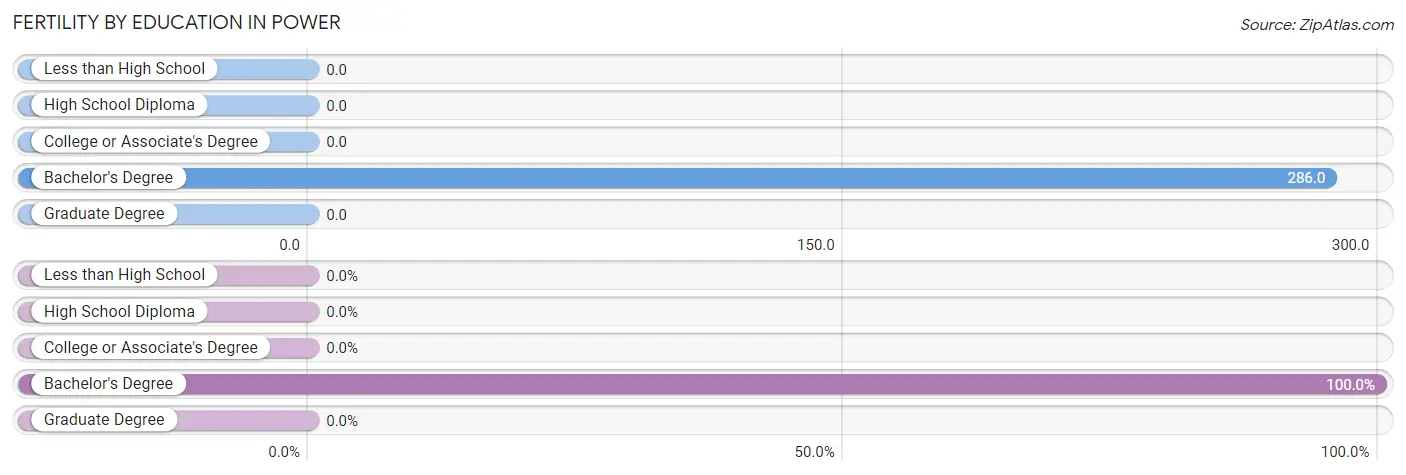
| Educational Attainment | Women with Births | Births / 1,000 Women |
| Less than High School | 0 (0.0%) | 0.0 |
| High School Diploma | 0 (0.0%) | 0.0 |
| College or Associate's Degree | 0 (0.0%) | 0.0 |
| Bachelor's Degree | 2 (100.0%) | 286.0 |
| Graduate Degree | 0 (0.0%) | 0.0 |
| Total | 2 (100.0%) | 61.0 |
Fertility by Education by Marriage Status in Power

| Educational Attainment | Married | Unmarried |
| Less than High School | 0 (0.0%) | 0 (0.0%) |
| High School Diploma | 0 (0.0%) | 0 (0.0%) |
| College or Associate's Degree | 0 (0.0%) | 0 (0.0%) |
| Bachelor's Degree | 2 (100.0%) | 0 (0.0%) |
| Graduate Degree | 0 (0.0%) | 0 (0.0%) |
| Total | 2 (100.0%) | 0 (0.0%) |
Employment Characteristics in Power
Employment by Class of Employer in Power
Among the 96 employed individuals in Power, private company employees (70 | 72.9%), state government employees (12 | 12.5%), and local government employees (7 | 7.3%) make up the most common classes of employment.

| Employer Class | # Employees | % Employees |
| Private Company Employees | 70 | 72.9% |
| Self-Employed (Incorporated) | 0 | 0.0% |
| Self-Employed (Not Incorporated) | 4 | 4.2% |
| Not-for-profit Organizations | 3 | 3.1% |
| Local Government Employees | 7 | 7.3% |
| State Government Employees | 12 | 12.5% |
| Federal Government Employees | 0 | 0.0% |
| Unpaid Family Workers | 0 | 0.0% |
| Total | 96 | 100.0% |
Employment Status by Age in Power

| Age Bracket | In Labor Force | Unemployed |
| 16 to 19 Years | 0 (0.0%) | 0 (0.0%) |
| 20 to 24 Years | 8 (100.0%) | 0 (0.0%) |
| 25 to 29 Years | 21 (100.0%) | 0 (0.0%) |
| 30 to 34 Years | 6 (100.0%) | 0 (0.0%) |
| 35 to 44 Years | 14 (60.9%) | 0 (0.0%) |
| 45 to 54 Years | 12 (85.7%) | 0 (0.0%) |
| 55 to 59 Years | 9 (81.8%) | 0 (0.0%) |
| 60 to 64 Years | 9 (56.3%) | 0 (0.0%) |
| 65 to 74 Years | 8 (30.8%) | 0 (0.0%) |
| 75 Years and over | 9 (52.9%) | 0 (0.0%) |
| Total | 96 (64.4%) | 0 (0.0%) |
Employment Status by Educational Attainment in Power

| Educational Attainment | In Labor Force | Unemployed |
| Less than High School | 0 (0.0%) | 0 (0.0%) |
| High School Diploma | 21 (75.0%) | 0 (0.0%) |
| College / Associate Degree | 33 (75.0%) | 0 (0.0%) |
| Bachelor's Degree or higher | 17 (89.5%) | 0 (0.0%) |
| Total | 71 (78.0%) | 0 (0.0%) |
Employment Occupations by Sex in Power
Management, Business, Science and Arts Occupations
The most common Management, Business, Science and Arts occupations in Power are Community & Social Service (9 | 9.4%), Management (7 | 7.3%), Education Instruction & Library (6 | 6.2%), Business & Financial (3 | 3.1%), and Education, Arts & Media (3 | 3.1%).
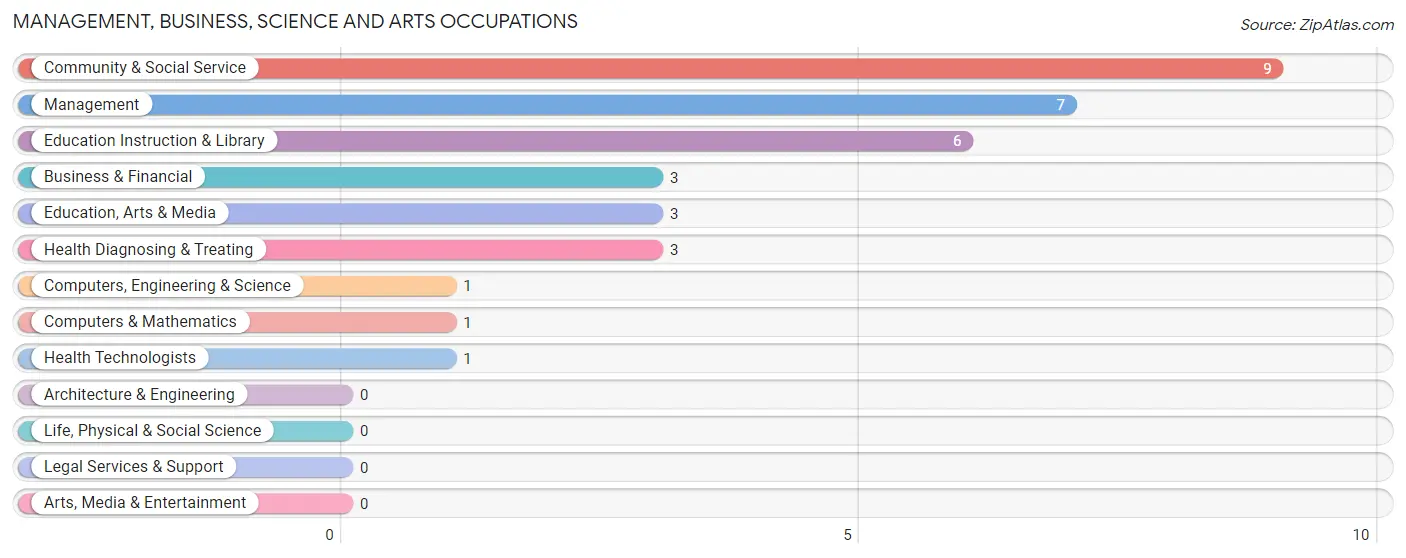
Management, Business, Science and Arts Occupations by Sex
Within the Management, Business, Science and Arts occupations in Power, the most male-oriented occupations are Computers, Engineering & Science (100.0%), Computers & Mathematics (100.0%), and Education Instruction & Library (83.3%), while the most female-oriented occupations are Business & Financial (100.0%), Education, Arts & Media (100.0%), and Health Diagnosing & Treating (100.0%).
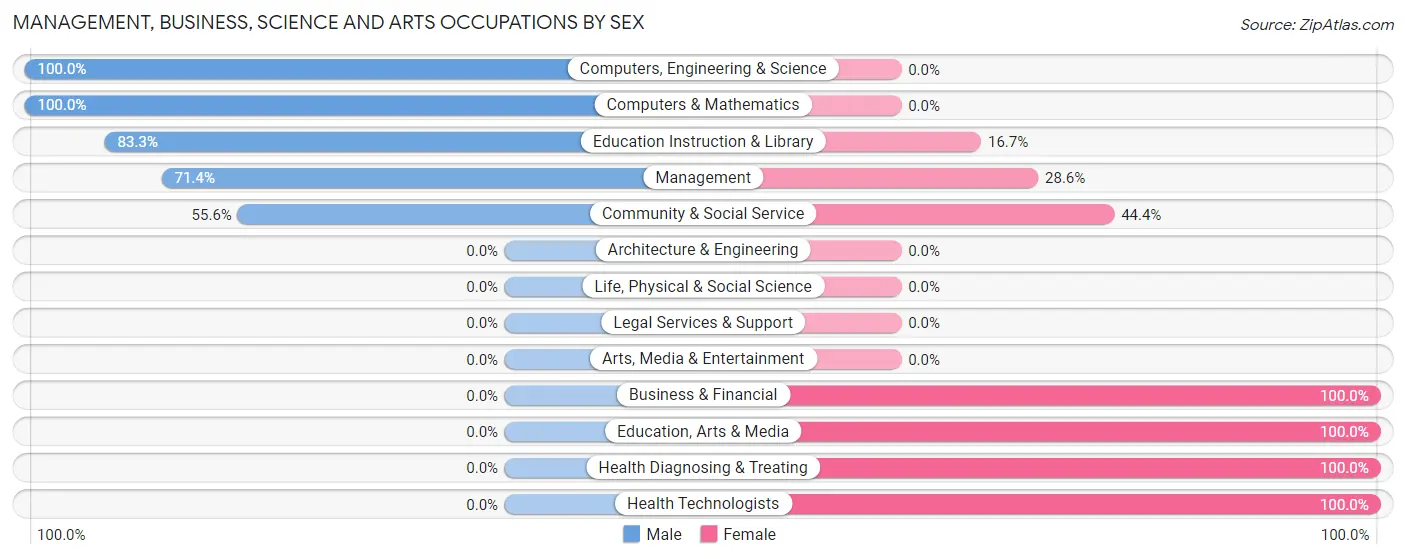
| Occupation | Male | Female |
| Management | 5 (71.4%) | 2 (28.6%) |
| Business & Financial | 0 (0.0%) | 3 (100.0%) |
| Computers, Engineering & Science | 1 (100.0%) | 0 (0.0%) |
| Computers & Mathematics | 1 (100.0%) | 0 (0.0%) |
| Architecture & Engineering | 0 (0.0%) | 0 (0.0%) |
| Life, Physical & Social Science | 0 (0.0%) | 0 (0.0%) |
| Community & Social Service | 5 (55.6%) | 4 (44.4%) |
| Education, Arts & Media | 0 (0.0%) | 3 (100.0%) |
| Legal Services & Support | 0 (0.0%) | 0 (0.0%) |
| Education Instruction & Library | 5 (83.3%) | 1 (16.7%) |
| Arts, Media & Entertainment | 0 (0.0%) | 0 (0.0%) |
| Health Diagnosing & Treating | 0 (0.0%) | 3 (100.0%) |
| Health Technologists | 0 (0.0%) | 1 (100.0%) |
| Total (Category) | 11 (47.8%) | 12 (52.2%) |
| Total (Overall) | 61 (63.5%) | 35 (36.5%) |
Services Occupations
The most common Services occupations in Power are , and Food Preparation & Serving (8 | 8.3%).

Services Occupations by Sex

| Occupation | Male | Female |
| Healthcare Support | 0 (0.0%) | 0 (0.0%) |
| Security & Protection | 0 (0.0%) | 0 (0.0%) |
| Firefighting & Prevention | 0 (0.0%) | 0 (0.0%) |
| Law Enforcement | 0 (0.0%) | 0 (0.0%) |
| Food Preparation & Serving | 0 (0.0%) | 8 (100.0%) |
| Cleaning & Maintenance | 0 (0.0%) | 0 (0.0%) |
| Personal Care & Service | 0 (0.0%) | 0 (0.0%) |
| Total (Category) | 0 (0.0%) | 8 (100.0%) |
| Total (Overall) | 61 (63.5%) | 35 (36.5%) |
Sales and Office Occupations
The most common Sales and Office occupations in Power are Sales & Related (12 | 12.5%), and Office & Administration (4 | 4.2%).

Sales and Office Occupations by Sex

| Occupation | Male | Female |
| Sales & Related | 4 (33.3%) | 8 (66.7%) |
| Office & Administration | 2 (50.0%) | 2 (50.0%) |
| Total (Category) | 6 (37.5%) | 10 (62.5%) |
| Total (Overall) | 61 (63.5%) | 35 (36.5%) |
Natural Resources, Construction and Maintenance Occupations
The most common Natural Resources, Construction and Maintenance occupations in Power are Construction & Extraction (15 | 15.6%), and Farming, Fishing & Forestry (9 | 9.4%).

Natural Resources, Construction and Maintenance Occupations by Sex

| Occupation | Male | Female |
| Farming, Fishing & Forestry | 9 (100.0%) | 0 (0.0%) |
| Construction & Extraction | 14 (93.3%) | 1 (6.7%) |
| Installation, Maintenance & Repair | 0 (0.0%) | 0 (0.0%) |
| Total (Category) | 23 (95.8%) | 1 (4.2%) |
| Total (Overall) | 61 (63.5%) | 35 (36.5%) |
Production, Transportation and Moving Occupations
The most common Production, Transportation and Moving occupations in Power are Transportation (23 | 24.0%), and Material Moving (2 | 2.1%).

Production, Transportation and Moving Occupations by Sex

| Occupation | Male | Female |
| Production | 0 (0.0%) | 0 (0.0%) |
| Transportation | 19 (82.6%) | 4 (17.4%) |
| Material Moving | 2 (100.0%) | 0 (0.0%) |
| Total (Category) | 21 (84.0%) | 4 (16.0%) |
| Total (Overall) | 61 (63.5%) | 35 (36.5%) |
Employment Industries by Sex in Power
Employment Industries in Power
The major employment industries in Power include Retail Trade (21 | 21.9%), Educational Services (20 | 20.8%), Construction (15 | 15.6%), Wholesale Trade (11 | 11.5%), and Agriculture, Fishing & Hunting (6 | 6.2%).
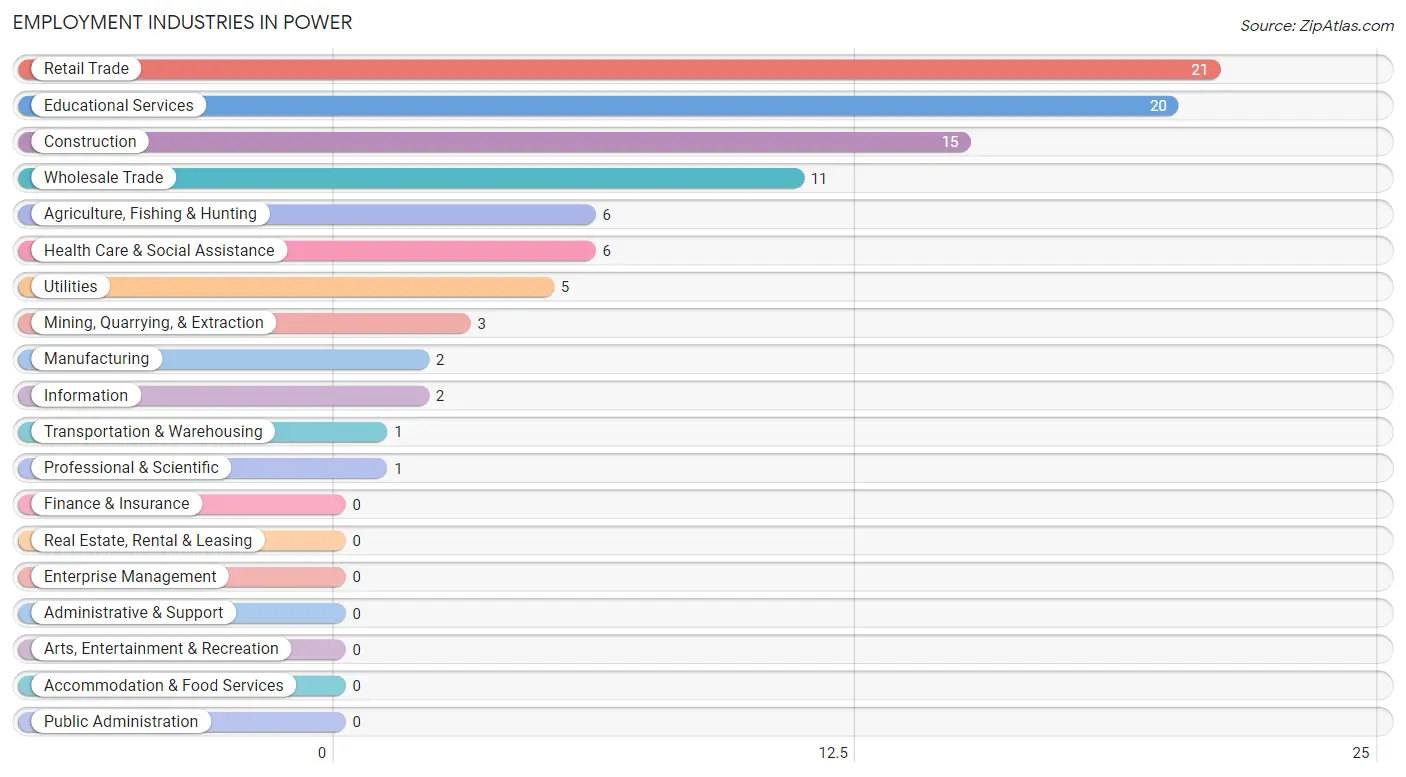
Employment Industries by Sex in Power
The Power industries that see more men than women are Agriculture, Fishing & Hunting (100.0%), Mining, Quarrying, & Extraction (100.0%), and Manufacturing (100.0%), whereas the industries that tend to have a higher number of women are Information (100.0%), Health Care & Social Assistance (100.0%), and Educational Services (75.0%).
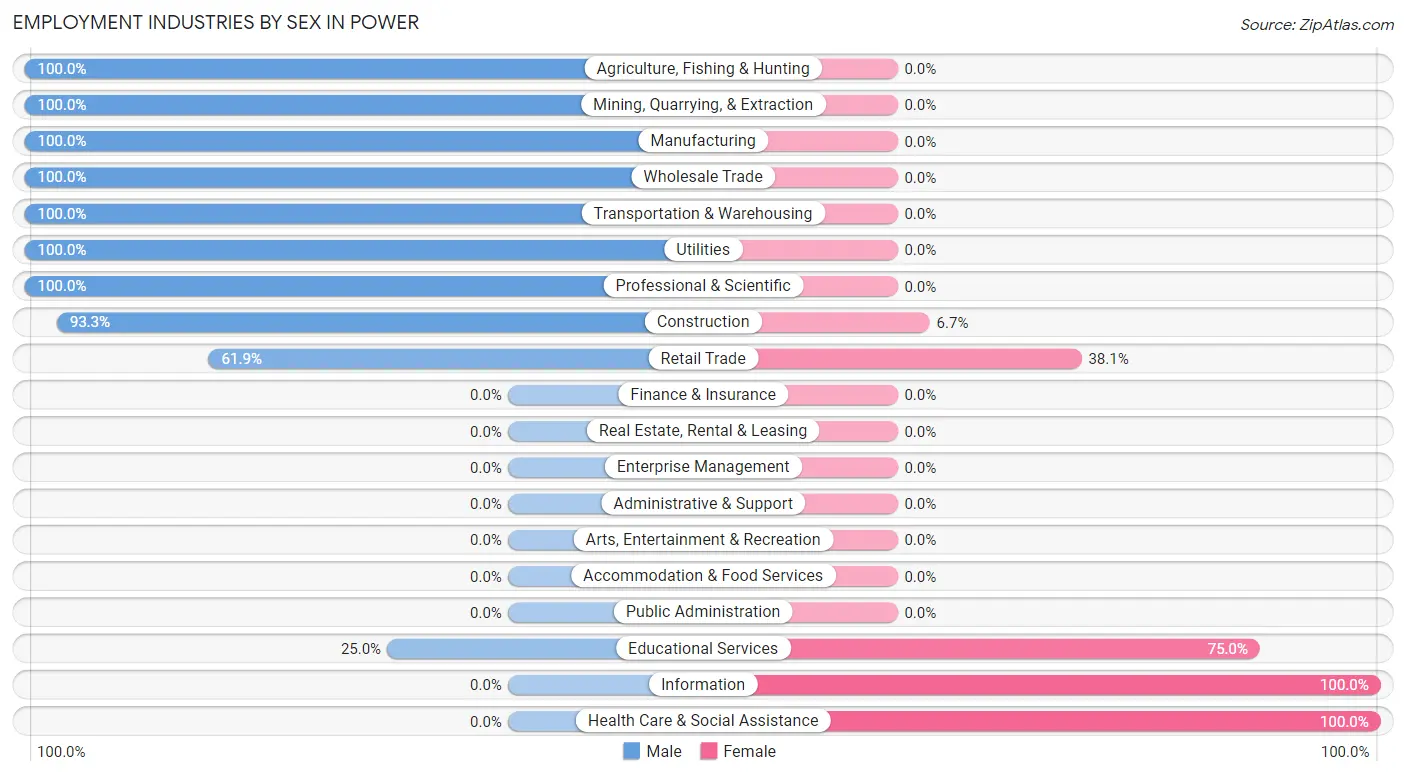
| Industry | Male | Female |
| Agriculture, Fishing & Hunting | 6 (100.0%) | 0 (0.0%) |
| Mining, Quarrying, & Extraction | 3 (100.0%) | 0 (0.0%) |
| Construction | 14 (93.3%) | 1 (6.7%) |
| Manufacturing | 2 (100.0%) | 0 (0.0%) |
| Wholesale Trade | 11 (100.0%) | 0 (0.0%) |
| Retail Trade | 13 (61.9%) | 8 (38.1%) |
| Transportation & Warehousing | 1 (100.0%) | 0 (0.0%) |
| Utilities | 5 (100.0%) | 0 (0.0%) |
| Information | 0 (0.0%) | 2 (100.0%) |
| Finance & Insurance | 0 (0.0%) | 0 (0.0%) |
| Real Estate, Rental & Leasing | 0 (0.0%) | 0 (0.0%) |
| Professional & Scientific | 1 (100.0%) | 0 (0.0%) |
| Enterprise Management | 0 (0.0%) | 0 (0.0%) |
| Administrative & Support | 0 (0.0%) | 0 (0.0%) |
| Educational Services | 5 (25.0%) | 15 (75.0%) |
| Health Care & Social Assistance | 0 (0.0%) | 6 (100.0%) |
| Arts, Entertainment & Recreation | 0 (0.0%) | 0 (0.0%) |
| Accommodation & Food Services | 0 (0.0%) | 0 (0.0%) |
| Public Administration | 0 (0.0%) | 0 (0.0%) |
| Total | 61 (63.5%) | 35 (36.5%) |
Education in Power
School Enrollment in Power
The most common levels of schooling among the 53 students in Power are elementary school (21 | 39.6%), middle school (10 | 18.9%), and college / undergraduate (9 | 17.0%).

| School Level | # Students | % Students |
| Nursery / Preschool | 5 | 9.4% |
| Kindergarten | 1 | 1.9% |
| Elementary School | 21 | 39.6% |
| Middle School | 10 | 18.9% |
| High School | 7 | 13.2% |
| College / Undergraduate | 9 | 17.0% |
| Graduate / Professional | 0 | 0.0% |
| Total | 53 | 100.0% |
School Enrollment by Age by Funding Source in Power

| Age Bracket | Public School | Private School |
| 3 to 4 Year Olds | 5 (100.0%) | 0 (0.0%) |
| 5 to 9 Year Old | 22 (100.0%) | 0 (0.0%) |
| 10 to 14 Year Olds | 10 (100.0%) | 0 (0.0%) |
| 15 to 17 Year Olds | 7 (100.0%) | 0 (0.0%) |
| 18 to 19 Year Olds | 0 (0.0%) | 0 (0.0%) |
| 20 to 24 Year Olds | 0 (0.0%) | 0 (0.0%) |
| 25 to 34 Year Olds | 8 (100.0%) | 0 (0.0%) |
| 35 Years and over | 1 (100.0%) | 0 (0.0%) |
| Total | 53 (100.0%) | 0 (0.0%) |
Educational Attainment by Field of Study in Power
Science & technology (6 | 26.1%), social sciences (5 | 21.7%), education (5 | 21.7%), psychology (3 | 13.0%), and engineering (2 | 8.7%) are the most common fields of study among 23 individuals in Power who have obtained a bachelor's degree or higher.
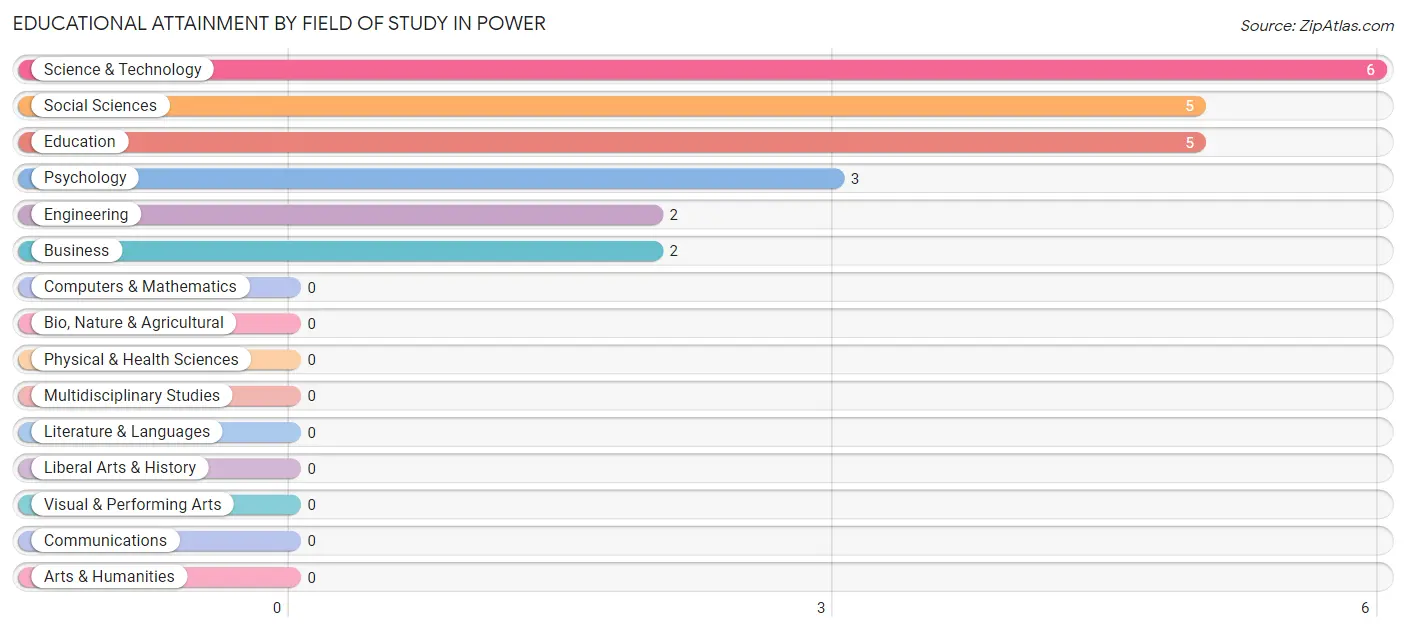
| Field of Study | # Graduates | % Graduates |
| Computers & Mathematics | 0 | 0.0% |
| Bio, Nature & Agricultural | 0 | 0.0% |
| Physical & Health Sciences | 0 | 0.0% |
| Psychology | 3 | 13.0% |
| Social Sciences | 5 | 21.7% |
| Engineering | 2 | 8.7% |
| Multidisciplinary Studies | 0 | 0.0% |
| Science & Technology | 6 | 26.1% |
| Business | 2 | 8.7% |
| Education | 5 | 21.7% |
| Literature & Languages | 0 | 0.0% |
| Liberal Arts & History | 0 | 0.0% |
| Visual & Performing Arts | 0 | 0.0% |
| Communications | 0 | 0.0% |
| Arts & Humanities | 0 | 0.0% |
| Total | 23 | 100.0% |
Transportation & Commute in Power
Vehicle Availability by Sex in Power
The most prevalent vehicle ownership categories in Power are males with 2 vehicles (19, accounting for 31.1%) and females with 2 vehicles (17, making up 54.3%).

| Vehicles Available | Male | Female |
| No Vehicle | 0 (0.0%) | 1 (2.9%) |
| 1 Vehicle | 0 (0.0%) | 2 (5.7%) |
| 2 Vehicles | 19 (31.1%) | 17 (48.6%) |
| 3 Vehicles | 19 (31.1%) | 7 (20.0%) |
| 4 Vehicles | 13 (21.3%) | 8 (22.9%) |
| 5 or more Vehicles | 10 (16.4%) | 0 (0.0%) |
| Total | 61 (100.0%) | 35 (100.0%) |
Commute Time in Power
The most frequently occuring commute durations in Power are less than 5 minutes (39 commuters, 41.9%), 25 to 29 minutes (10 commuters, 10.7%), and 30 to 34 minutes (10 commuters, 10.7%).
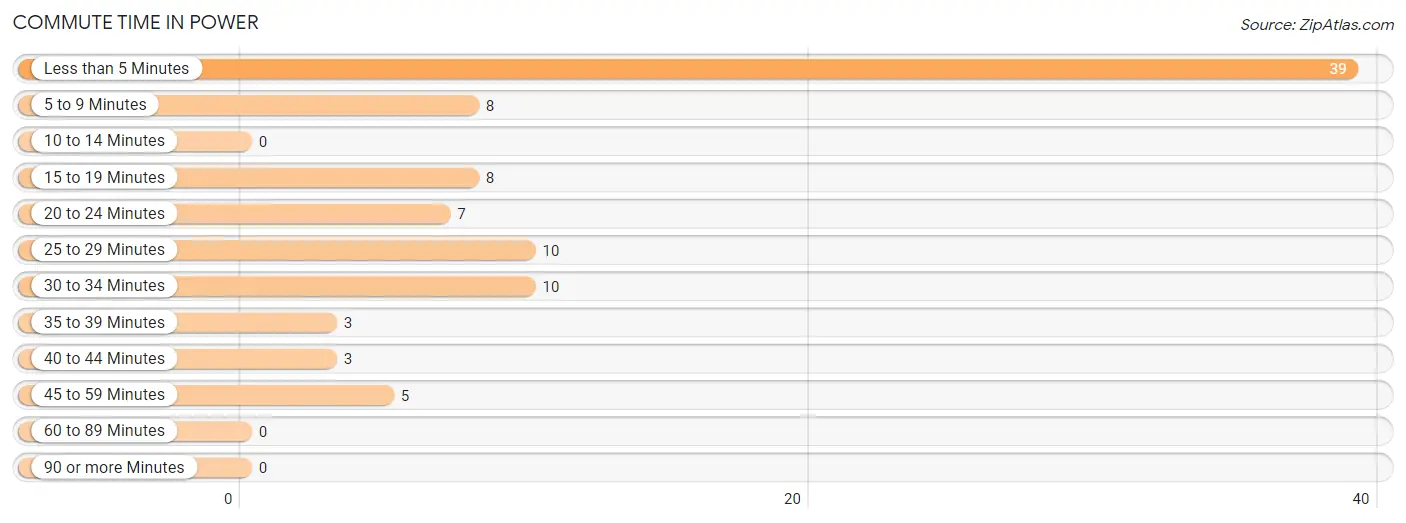
| Commute Time | # Commuters | % Commuters |
| Less than 5 Minutes | 39 | 41.9% |
| 5 to 9 Minutes | 8 | 8.6% |
| 10 to 14 Minutes | 0 | 0.0% |
| 15 to 19 Minutes | 8 | 8.6% |
| 20 to 24 Minutes | 7 | 7.5% |
| 25 to 29 Minutes | 10 | 10.7% |
| 30 to 34 Minutes | 10 | 10.7% |
| 35 to 39 Minutes | 3 | 3.2% |
| 40 to 44 Minutes | 3 | 3.2% |
| 45 to 59 Minutes | 5 | 5.4% |
| 60 to 89 Minutes | 0 | 0.0% |
| 90 or more Minutes | 0 | 0.0% |
Commute Time by Sex in Power
The most common commute times in Power are less than 5 minutes (26 commuters, 42.6%) for males and less than 5 minutes (13 commuters, 40.6%) for females.
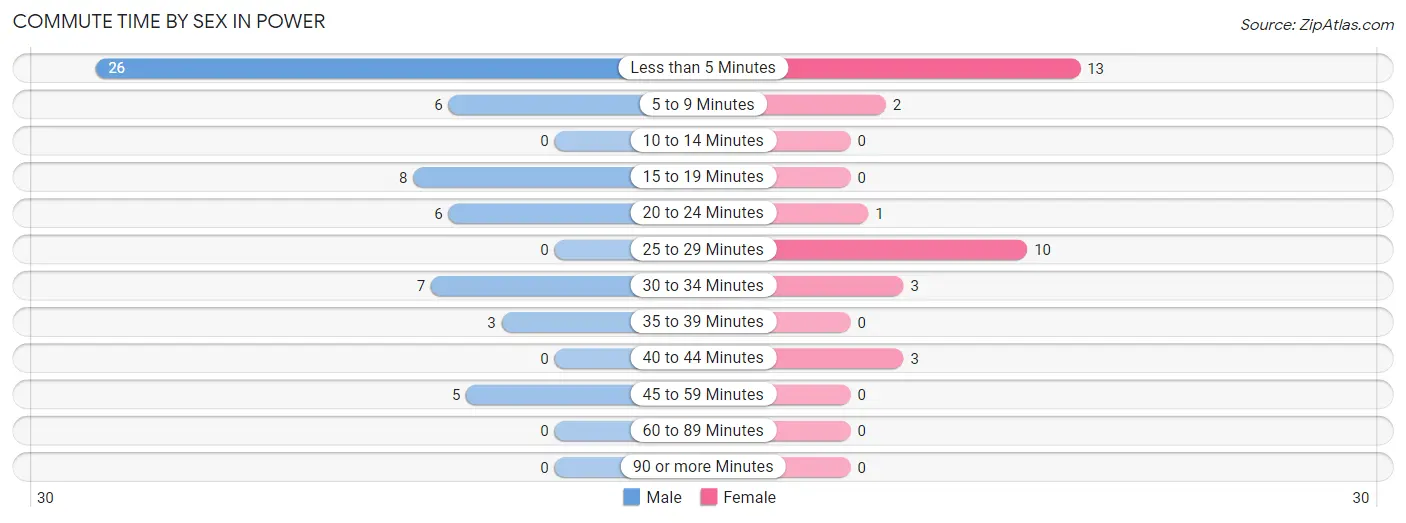
| Commute Time | Male | Female |
| Less than 5 Minutes | 26 (42.6%) | 13 (40.6%) |
| 5 to 9 Minutes | 6 (9.8%) | 2 (6.2%) |
| 10 to 14 Minutes | 0 (0.0%) | 0 (0.0%) |
| 15 to 19 Minutes | 8 (13.1%) | 0 (0.0%) |
| 20 to 24 Minutes | 6 (9.8%) | 1 (3.1%) |
| 25 to 29 Minutes | 0 (0.0%) | 10 (31.2%) |
| 30 to 34 Minutes | 7 (11.5%) | 3 (9.4%) |
| 35 to 39 Minutes | 3 (4.9%) | 0 (0.0%) |
| 40 to 44 Minutes | 0 (0.0%) | 3 (9.4%) |
| 45 to 59 Minutes | 5 (8.2%) | 0 (0.0%) |
| 60 to 89 Minutes | 0 (0.0%) | 0 (0.0%) |
| 90 or more Minutes | 0 (0.0%) | 0 (0.0%) |
Time of Departure to Work by Sex in Power
The most frequent times of departure to work in Power are 7:00 AM to 7:29 AM (24, 39.3%) for males and 8:00 AM to 8:29 AM (20, 62.5%) for females.
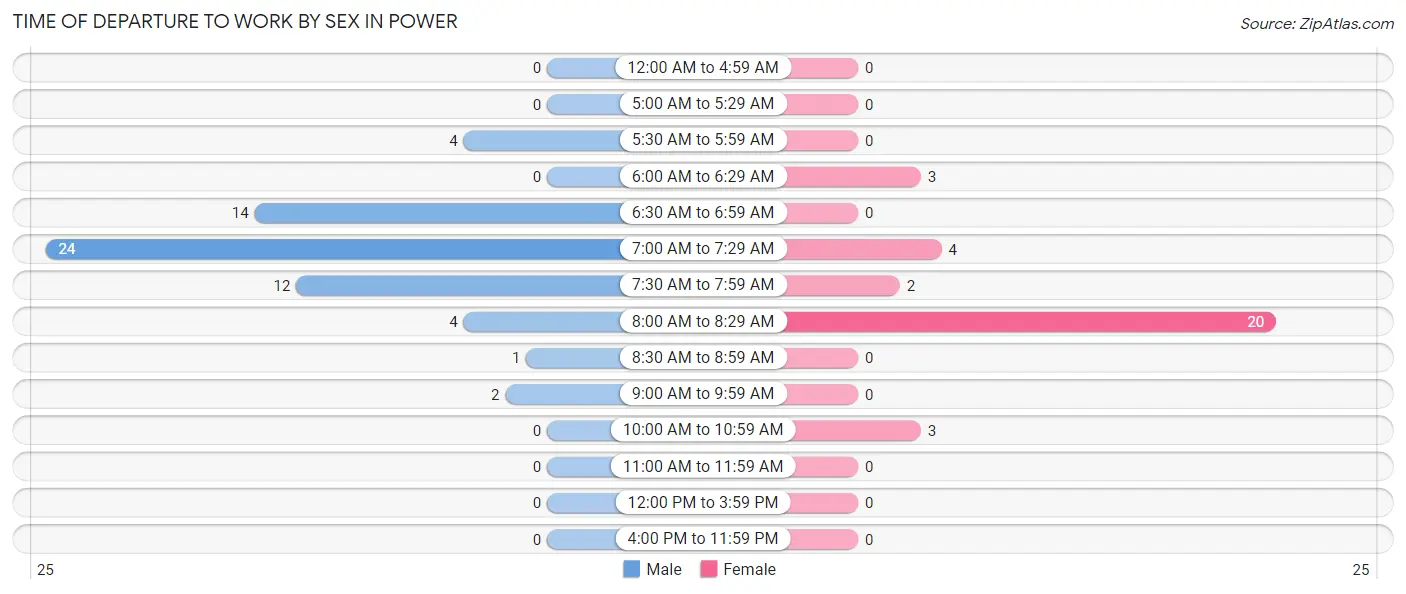
| Time of Departure | Male | Female |
| 12:00 AM to 4:59 AM | 0 (0.0%) | 0 (0.0%) |
| 5:00 AM to 5:29 AM | 0 (0.0%) | 0 (0.0%) |
| 5:30 AM to 5:59 AM | 4 (6.6%) | 0 (0.0%) |
| 6:00 AM to 6:29 AM | 0 (0.0%) | 3 (9.4%) |
| 6:30 AM to 6:59 AM | 14 (23.0%) | 0 (0.0%) |
| 7:00 AM to 7:29 AM | 24 (39.3%) | 4 (12.5%) |
| 7:30 AM to 7:59 AM | 12 (19.7%) | 2 (6.2%) |
| 8:00 AM to 8:29 AM | 4 (6.6%) | 20 (62.5%) |
| 8:30 AM to 8:59 AM | 1 (1.6%) | 0 (0.0%) |
| 9:00 AM to 9:59 AM | 2 (3.3%) | 0 (0.0%) |
| 10:00 AM to 10:59 AM | 0 (0.0%) | 3 (9.4%) |
| 11:00 AM to 11:59 AM | 0 (0.0%) | 0 (0.0%) |
| 12:00 PM to 3:59 PM | 0 (0.0%) | 0 (0.0%) |
| 4:00 PM to 11:59 PM | 0 (0.0%) | 0 (0.0%) |
| Total | 61 (100.0%) | 32 (100.0%) |
Housing Occupancy in Power
Occupancy by Ownership in Power
Of the total 91 dwellings in Power, owner-occupied units account for 84 (92.3%), while renter-occupied units make up 7 (7.7%).

| Occupancy | # Housing Units | % Housing Units |
| Owner Occupied Housing Units | 84 | 92.3% |
| Renter-Occupied Housing Units | 7 | 7.7% |
| Total Occupied Housing Units | 91 | 100.0% |
Occupancy by Household Size in Power

| Household Size | # Housing Units | % Housing Units |
| 1-Person Household | 43 | 47.2% |
| 2-Person Household | 31 | 34.1% |
| 3-Person Household | 1 | 1.1% |
| 4+ Person Household | 16 | 17.6% |
| Total Housing Units | 91 | 100.0% |
Occupancy by Ownership by Household Size in Power

| Household Size | Owner-occupied | Renter-occupied |
| 1-Person Household | 43 (100.0%) | 0 (0.0%) |
| 2-Person Household | 26 (83.9%) | 5 (16.1%) |
| 3-Person Household | 1 (100.0%) | 0 (0.0%) |
| 4+ Person Household | 14 (87.5%) | 2 (12.5%) |
| Total Housing Units | 84 (92.3%) | 7 (7.7%) |
Occupancy by Educational Attainment in Power

| Household Size | Owner-occupied | Renter-occupied |
| Less than High School | 0 (0.0%) | 0 (0.0%) |
| High School Diploma | 29 (100.0%) | 0 (0.0%) |
| College/Associate Degree | 50 (98.0%) | 1 (2.0%) |
| Bachelor's Degree or higher | 5 (45.5%) | 6 (54.5%) |
Occupancy by Age of Householder in Power

| Age Bracket | # Households | % Households |
| Under 35 Years | 21 | 23.1% |
| 35 to 44 Years | 10 | 11.0% |
| 45 to 54 Years | 7 | 7.7% |
| 55 to 64 Years | 15 | 16.5% |
| 65 to 74 Years | 21 | 23.1% |
| 75 to 84 Years | 14 | 15.4% |
| 85 Years and Over | 3 | 3.3% |
| Total | 91 | 100.0% |
Housing Finances in Power
Median Income by Occupancy in Power

| Occupancy Type | # Households | Median Income |
| Owner-Occupied | 84 (92.3%) | $65,000 |
| Renter-Occupied | 7 (7.7%) | $80,750 |
| Average | 91 (100.0%) | $70,375 |
Occupancy by Householder Income Bracket in Power
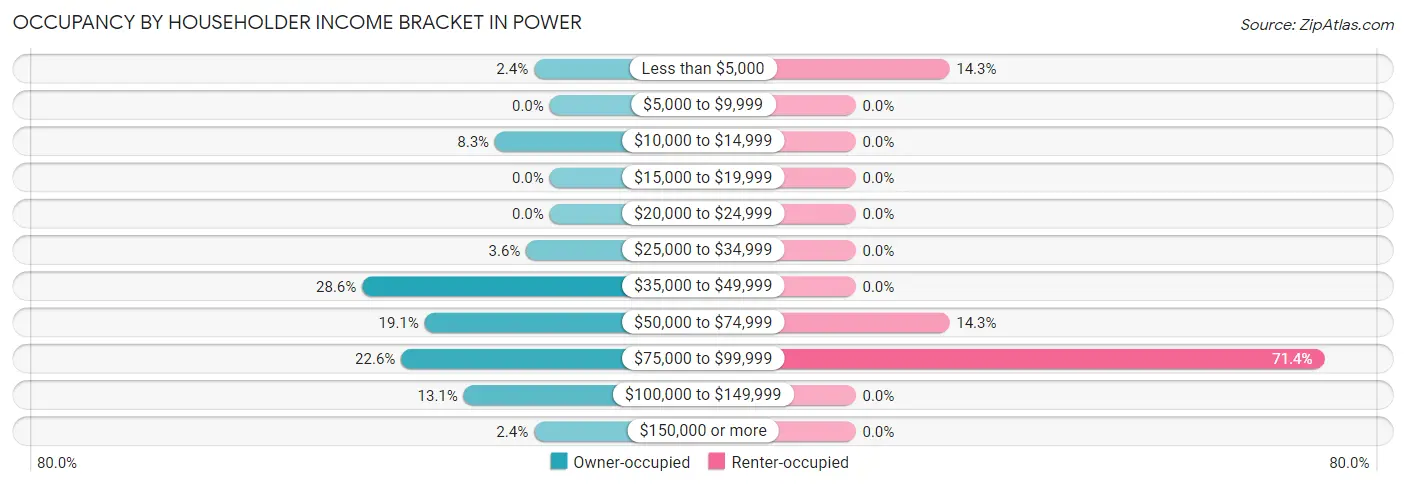
| Income Bracket | Owner-occupied | Renter-occupied |
| Less than $5,000 | 2 (2.4%) | 1 (14.3%) |
| $5,000 to $9,999 | 0 (0.0%) | 0 (0.0%) |
| $10,000 to $14,999 | 7 (8.3%) | 0 (0.0%) |
| $15,000 to $19,999 | 0 (0.0%) | 0 (0.0%) |
| $20,000 to $24,999 | 0 (0.0%) | 0 (0.0%) |
| $25,000 to $34,999 | 3 (3.6%) | 0 (0.0%) |
| $35,000 to $49,999 | 24 (28.6%) | 0 (0.0%) |
| $50,000 to $74,999 | 16 (19.1%) | 1 (14.3%) |
| $75,000 to $99,999 | 19 (22.6%) | 5 (71.4%) |
| $100,000 to $149,999 | 11 (13.1%) | 0 (0.0%) |
| $150,000 or more | 2 (2.4%) | 0 (0.0%) |
| Total | 84 (100.0%) | 7 (100.0%) |
Monthly Housing Cost Tiers in Power

| Monthly Cost | Owner-occupied | Renter-occupied |
| Less than $300 | 6 (7.1%) | 0 (0.0%) |
| $300 to $499 | 11 (13.1%) | 5 (71.4%) |
| $500 to $799 | 15 (17.9%) | 2 (28.6%) |
| $800 to $999 | 22 (26.2%) | 0 (0.0%) |
| $1,000 to $1,499 | 20 (23.8%) | 0 (0.0%) |
| $1,500 to $1,999 | 10 (11.9%) | 0 (0.0%) |
| $2,000 to $2,499 | 0 (0.0%) | 0 (0.0%) |
| $2,500 to $2,999 | 0 (0.0%) | 0 (0.0%) |
| $3,000 or more | 0 (0.0%) | 0 (0.0%) |
| Total | 84 (100.0%) | 7 (100.0%) |
Physical Housing Characteristics in Power
Housing Structures in Power

| Structure Type | # Housing Units | % Housing Units |
| Single Unit, Detached | 70 | 76.9% |
| Single Unit, Attached | 1 | 1.1% |
| 2 Unit Apartments | 0 | 0.0% |
| 3 or 4 Unit Apartments | 0 | 0.0% |
| 5 to 9 Unit Apartments | 0 | 0.0% |
| 10 or more Apartments | 0 | 0.0% |
| Mobile Home / Other | 20 | 22.0% |
| Total | 91 | 100.0% |
Housing Structures by Occupancy in Power

| Structure Type | Owner-occupied | Renter-occupied |
| Single Unit, Detached | 64 (91.4%) | 6 (8.6%) |
| Single Unit, Attached | 0 (0.0%) | 1 (100.0%) |
| 2 Unit Apartments | 0 (0.0%) | 0 (0.0%) |
| 3 or 4 Unit Apartments | 0 (0.0%) | 0 (0.0%) |
| 5 to 9 Unit Apartments | 0 (0.0%) | 0 (0.0%) |
| 10 or more Apartments | 0 (0.0%) | 0 (0.0%) |
| Mobile Home / Other | 20 (100.0%) | 0 (0.0%) |
| Total | 84 (92.3%) | 7 (7.7%) |
Housing Structures by Number of Rooms in Power

| Number of Rooms | Owner-occupied | Renter-occupied |
| 1 Room | 0 (0.0%) | 0 (0.0%) |
| 2 or 3 Rooms | 2 (2.4%) | 0 (0.0%) |
| 4 or 5 Rooms | 22 (26.2%) | 6 (85.7%) |
| 6 or 7 Rooms | 25 (29.8%) | 1 (14.3%) |
| 8 or more Rooms | 35 (41.7%) | 0 (0.0%) |
| Total | 84 (100.0%) | 7 (100.0%) |
Housing Structure by Heating Type in Power

| Heating Type | Owner-occupied | Renter-occupied |
| Utility Gas | 4 (4.8%) | 0 (0.0%) |
| Bottled, Tank, or LP Gas | 61 (72.6%) | 7 (100.0%) |
| Electricity | 4 (4.8%) | 0 (0.0%) |
| Fuel Oil or Kerosene | 12 (14.3%) | 0 (0.0%) |
| Coal or Coke | 0 (0.0%) | 0 (0.0%) |
| All other Fuels | 3 (3.6%) | 0 (0.0%) |
| No Fuel Used | 0 (0.0%) | 0 (0.0%) |
| Total | 84 (100.0%) | 7 (100.0%) |
Household Vehicle Usage in Power

| Vehicles per Household | Owner-occupied | Renter-occupied |
| No Vehicle | 0 (0.0%) | 1 (14.3%) |
| 1 Vehicle | 18 (21.4%) | 0 (0.0%) |
| 2 Vehicles | 24 (28.6%) | 6 (85.7%) |
| 3 or more Vehicles | 42 (50.0%) | 0 (0.0%) |
| Total | 84 (100.0%) | 7 (100.0%) |
Real Estate & Mortgages in Power
Real Estate and Mortgage Overview in Power
| Characteristic | Without Mortgage | With Mortgage |
| Housing Units | 40 | 44 |
| Median Property Value | $177,800 | $150,000 |
| Median Household Income | $73,750 | $2 |
| Monthly Housing Costs | $700 | $0 |
| Real Estate Taxes | $911 | $0 |
Property Value by Mortgage Status in Power

| Property Value | Without Mortgage | With Mortgage |
| Less than $50,000 | 9 (22.5%) | 2 (4.5%) |
| $50,000 to $99,999 | 7 (17.5%) | 0 (0.0%) |
| $100,000 to $299,999 | 24 (60.0%) | 40 (90.9%) |
| $300,000 to $499,999 | 0 (0.0%) | 2 (4.5%) |
| $500,000 to $749,999 | 0 (0.0%) | 0 (0.0%) |
| $750,000 to $999,999 | 0 (0.0%) | 0 (0.0%) |
| $1,000,000 or more | 0 (0.0%) | 0 (0.0%) |
| Total | 40 (100.0%) | 44 (100.0%) |
Household Income by Mortgage Status in Power

| Household Income | Without Mortgage | With Mortgage |
| Less than $10,000 | 2 (5.0%) | 0 (0.0%) |
| $10,000 to $24,999 | 2 (5.0%) | 0 (0.0%) |
| $25,000 to $34,999 | 0 (0.0%) | 5 (11.4%) |
| $35,000 to $49,999 | 12 (30.0%) | 3 (6.8%) |
| $50,000 to $74,999 | 4 (10.0%) | 12 (27.3%) |
| $75,000 to $99,999 | 10 (25.0%) | 12 (27.3%) |
| $100,000 to $149,999 | 10 (25.0%) | 9 (20.4%) |
| $150,000 or more | 0 (0.0%) | 1 (2.3%) |
| Total | 40 (100.0%) | 44 (100.0%) |
Property Value to Household Income Ratio in Power

| Value-to-Income Ratio | Without Mortgage | With Mortgage |
| Less than 2.0x | 11 (27.5%) | 56,250 (127,840.9%) |
| 2.0x to 2.9x | 10 (25.0%) | 10 (22.7%) |
| 3.0x to 3.9x | 17 (42.5%) | 8 (18.2%) |
| 4.0x or more | 0 (0.0%) | 19 (43.2%) |
| Total | 40 (100.0%) | 44 (100.0%) |
Real Estate Taxes by Mortgage Status in Power

| Property Taxes | Without Mortgage | With Mortgage |
| Less than $800 | 14 (35.0%) | 0 (0.0%) |
| $800 to $1,499 | 13 (32.5%) | 2 (4.5%) |
| $800 to $1,499 | 11 (27.5%) | 29 (65.9%) |
| Total | 40 (100.0%) | 44 (100.0%) |
Health & Disability in Power
Health Insurance Coverage by Age in Power

| Age Bracket | With Coverage | Without Coverage |
| Under 6 Years | 16 (100.0%) | 0 (0.0%) |
| 6 to 18 Years | 39 (100.0%) | 0 (0.0%) |
| 19 to 25 Years | 16 (100.0%) | 0 (0.0%) |
| 26 to 34 Years | 19 (100.0%) | 0 (0.0%) |
| 35 to 44 Years | 19 (82.6%) | 4 (17.4%) |
| 45 to 54 Years | 14 (100.0%) | 0 (0.0%) |
| 55 to 64 Years | 27 (100.0%) | 0 (0.0%) |
| 65 to 74 Years | 26 (100.0%) | 0 (0.0%) |
| 75 Years and older | 17 (100.0%) | 0 (0.0%) |
| Total | 193 (98.0%) | 4 (2.0%) |
Health Insurance Coverage by Citizenship Status in Power

| Citizenship Status | With Coverage | Without Coverage |
| Native Born | 16 (100.0%) | 0 (0.0%) |
| Foreign Born, Citizen | 39 (100.0%) | 0 (0.0%) |
| Foreign Born, not a Citizen | 16 (100.0%) | 0 (0.0%) |
Health Insurance Coverage by Household Income in Power

| Household Income | With Coverage | Without Coverage |
| Under $25,000 | 16 (100.0%) | 0 (0.0%) |
| $25,000 to $49,999 | 28 (100.0%) | 0 (0.0%) |
| $50,000 to $74,999 | 26 (96.3%) | 1 (3.7%) |
| $75,000 to $99,999 | 95 (100.0%) | 0 (0.0%) |
| $100,000 and over | 28 (90.3%) | 3 (9.7%) |
Public vs Private Health Insurance Coverage by Age in Power

| Age Bracket | Public Insurance | Private Insurance |
| Under 6 | 14 (87.5%) | 13 (81.2%) |
| 6 to 18 Years | 20 (51.3%) | 34 (87.2%) |
| 19 to 25 Years | 0 (0.0%) | 16 (100.0%) |
| 25 to 34 Years | 4 (21.0%) | 15 (78.9%) |
| 35 to 44 Years | 2 (8.7%) | 17 (73.9%) |
| 45 to 54 Years | 2 (14.3%) | 14 (100.0%) |
| 55 to 64 Years | 7 (25.9%) | 24 (88.9%) |
| 65 to 74 Years | 26 (100.0%) | 24 (92.3%) |
| 75 Years and over | 17 (100.0%) | 15 (88.2%) |
| Total | 92 (46.7%) | 172 (87.3%) |
Disability Status by Sex by Age in Power

| Age Bracket | Male | Female |
| Under 5 Years | 0 (0.0%) | 0 (0.0%) |
| 5 to 17 Years | 0 (0.0%) | 0 (0.0%) |
| 18 to 34 Years | 0 (0.0%) | 0 (0.0%) |
| 35 to 64 Years | 2 (6.7%) | 4 (11.8%) |
| 65 to 74 Years | 0 (0.0%) | 13 (61.9%) |
| 75 Years and over | 12 (80.0%) | 2 (100.0%) |
Disability Class by Sex by Age in Power
Disability Class: Hearing Difficulty

| Age Bracket | Male | Female |
| Under 5 Years | 0 (0.0%) | 0 (0.0%) |
| 5 to 17 Years | 0 (0.0%) | 0 (0.0%) |
| 18 to 34 Years | 0 (0.0%) | 0 (0.0%) |
| 35 to 64 Years | 2 (6.7%) | 2 (5.9%) |
| 65 to 74 Years | 0 (0.0%) | 12 (57.1%) |
| 75 Years and over | 9 (60.0%) | 2 (100.0%) |
Disability Class: Vision Difficulty

| Age Bracket | Male | Female |
| Under 5 Years | 0 (0.0%) | 0 (0.0%) |
| 5 to 17 Years | 0 (0.0%) | 0 (0.0%) |
| 18 to 34 Years | 0 (0.0%) | 0 (0.0%) |
| 35 to 64 Years | 0 (0.0%) | 0 (0.0%) |
| 65 to 74 Years | 0 (0.0%) | 0 (0.0%) |
| 75 Years and over | 3 (20.0%) | 0 (0.0%) |
Disability Class: Cognitive Difficulty

| Age Bracket | Male | Female |
| 5 to 17 Years | 0 (0.0%) | 0 (0.0%) |
| 18 to 34 Years | 0 (0.0%) | 0 (0.0%) |
| 35 to 64 Years | 0 (0.0%) | 0 (0.0%) |
| 65 to 74 Years | 0 (0.0%) | 0 (0.0%) |
| 75 Years and over | 0 (0.0%) | 0 (0.0%) |
Disability Class: Ambulatory Difficulty

| Age Bracket | Male | Female |
| 5 to 17 Years | 0 (0.0%) | 0 (0.0%) |
| 18 to 34 Years | 0 (0.0%) | 0 (0.0%) |
| 35 to 64 Years | 0 (0.0%) | 2 (5.9%) |
| 65 to 74 Years | 0 (0.0%) | 1 (4.8%) |
| 75 Years and over | 3 (20.0%) | 2 (100.0%) |
Disability Class: Self-Care Difficulty

| Age Bracket | Male | Female |
| 5 to 17 Years | 0 (0.0%) | 0 (0.0%) |
| 18 to 34 Years | 0 (0.0%) | 0 (0.0%) |
| 35 to 64 Years | 0 (0.0%) | 2 (5.9%) |
| 65 to 74 Years | 0 (0.0%) | 1 (4.8%) |
| 75 Years and over | 0 (0.0%) | 0 (0.0%) |
Technology Access in Power
Computing Device Access in Power

| Device Type | # Households | % Households |
| Desktop or Laptop | 54 | 59.3% |
| Smartphone | 68 | 74.7% |
| Tablet | 58 | 63.7% |
| No Computing Device | 20 | 22.0% |
| Total | 91 | 100.0% |
Internet Access in Power

| Internet Type | # Households | % Households |
| Dial-Up Internet | 0 | 0.0% |
| Broadband Home | 68 | 74.7% |
| Cellular Data Only | 2 | 2.2% |
| Satellite Internet | 0 | 0.0% |
| No Internet | 21 | 23.1% |
| Total | 91 | 100.0% |
Power Summary
Power
Montana is the fourth largest state in the United States, with a population of 1,005,141 as of 2019. It is the 44th most populous state in the country. Montana is a state with a strong sense of independence and self-reliance, and its citizens have a long history of fighting for their rights. Montana is a state with a strong sense of individualism and a commitment to protecting its natural resources.
History
Montana has a rich and varied history. The area was first inhabited by Native American tribes, including the Blackfeet, Crow, Cheyenne, and Sioux. The first Europeans to explore the area were French fur traders in the late 1700s. In 1803, the United States acquired the area as part of the Louisiana Purchase. In 1805, the Lewis and Clark Expedition explored the area, and in 1864, the Montana Territory was established.
In 1889, Montana became the 41st state in the Union. During the late 19th century, Montana experienced a period of rapid growth and development, as gold and silver were discovered in the area. This led to a population boom, and the state quickly became an important center of industry and commerce.
Geography
Montana is located in the northern Rocky Mountains region of the United States. It is bordered by Idaho to the west, Wyoming to the south, North Dakota and South Dakota to the east, and Canada to the north. Montana is the fourth largest state in the country, with an area of 147,042 square miles.
Montana is a land of vast open spaces, with mountains, plains, and valleys. The Rocky Mountains run through the western part of the state, while the Great Plains cover the eastern part. The highest point in the state is Granite Peak, which is 12,807 feet above sea level. The state also has numerous rivers, including the Missouri, Yellowstone, and Flathead.
Economy
Montana has a diverse economy, with a mix of industries including agriculture, mining, manufacturing, and tourism. Agriculture is the largest sector of the state’s economy, accounting for about 20% of the state’s total economic output. The state is a major producer of wheat, barley, and hay, as well as beef and dairy products.
Mining is also an important part of the state’s economy, with coal, copper, and gold being the most important minerals. Manufacturing is also an important sector, with the state producing a variety of products including lumber, paper, and food products. Tourism is also an important part of the state’s economy, with millions of visitors coming to the state each year to enjoy its natural beauty and outdoor activities.
Demographics
As of 2019, the population of Montana was 1,005,141. The state has a population density of 6.9 people per square mile, making it the fourth least densely populated state in the country. The largest city in the state is Billings, with a population of 109,059.
The racial makeup of the state is 87.3% White, 6.2% Native American, 1.2% Asian, 0.7% Black, and 4.6% from other races. The median household income in the state is $51,939, and the median age is 38.7 years. The state has a higher-than-average rate of poverty, with 14.3% of the population living below the poverty line.
Common Questions
What is Per Capita Income in Power?
Per Capita income in Power is $28,771.
What is the Median Family Income in Power?
Median Family Income in Power is $80,250.
What is the Median Household income in Power?
Median Household Income in Power is $70,375.
What is Income or Wage Gap in Power?
Income or Wage Gap in Power is 18.6%.
Women in Power earn 81.4 cents for every dollar earned by a man.
What is Inequality or Gini Index in Power?
Inequality or Gini Index in Power is 0.28.
What is the Total Population of Power?
Total Population of Power is 197.
What is the Total Male Population of Power?
Total Male Population of Power is 96.
What is the Total Female Population of Power?
Total Female Population of Power is 101.
What is the Ratio of Males per 100 Females in Power?
There are 95.05 Males per 100 Females in Power.
What is the Ratio of Females per 100 Males in Power?
There are 105.21 Females per 100 Males in Power.
What is the Median Population Age in Power?
Median Population Age in Power is 41.1 Years.
What is the Average Family Size in Power
Average Family Size in Power is 3.3 People.
What is the Average Household Size in Power
Average Household Size in Power is 2.2 People.
How Large is the Labor Force in Power?
There are 96 People in the Labor Forcein in Power.
What is the Percentage of People in the Labor Force in Power?
64.4% of People are in the Labor Force in Power.